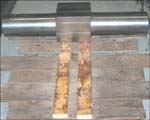Forging Raises The Bar On Magnesium Die Casting
Magnesium is emerging as 'the new aluminum' because of its light weight. As a result, hot-chamber magnesium die casting is gaining popularity in manufacturing.
Magnesium is emerging as "the new aluminum" because of its light weight. As a result, hot-chamber magnesium die casting is gaining popularity in manufacturing. The process produces magnesium parts with precise dimensions in a range of configurations, but it can be demanding on die casting machines, particularly on the gooseneck that delivers the molten magnesium to the die.
Sloan Industries, Inc. (Wood Dale, Illinois), a precision machine shop that supplies wear parts to the magnesium die casting industry, has found that using forged rather than cast goosenecks can yield better machine performance and part quality. Together with Scot Forge (Spring Grove, Illinois), the company has begun supplying forged goosenecks to the manufacturing industry, and they are able to do so competitively because of creative engineering.
"It was critical for us to supply an enhanced product to support our growing customer base in the magnesium die casting industry," says Henry Slowinski, Sloan Industries' president. "Magnesium is becoming the preferred material in high-tech, space and other industries because of its strength-to-weight ratio, dimensional stability and its ability to be recycled," he notes. "It isn't as brittle as aluminum."
The hot chamber magnesium die casting process uses a gooseneck and piston to inject molten magnesium into a die. The gooseneck is submerged into molten magnesium, and through the side fill holes, the gooseneck cavity is filled with the metal. The piston forces the molten metal down from the top, delivering the metal through the gooseneck's vertical delivery hole, nozzle and into the die without exposure to the environment. After the metal turns solid inside the die cavity, the die opens, the part is ejected and, at the same time, the piston retracts to its initial position above the fill holes. The die is again closed, and the gooseneck is filled with molten metal and ready for the next injection.
Sloan Industries supplies goosenecks in sizes ranging from 80 tons to 528 tons. These goosenecks must be able to withstand temperatures of 1,300 degrees, and they must hold up against magnesium, which is highly abrasive. Until recently, the goosenecks that the company offered were made from sand castings, but imperfections in the cast goosenecks were causing cracking, porosity and machining problems.
"The specifications called for DIN 1.2888 cast steel, which would hold up under the chemical and high-temperature demands, but it was expensive and difficult to cast," says company Vice President Adam Niedospial. "The inconsistency of cast goosenecks and shrink pockets caused delays in machining. As many as 40 percent of the castings had to be scrapped before supplying our customers, which was costly and affected our on-time delivery."
The company looked for an alternative to castings, and it considered making the goosenecks from solid bar. However, this method would require excessive material and machining, and as a result, the associated costs would make it impossible for the company to stay competitive.
Forging was an attractive alternative to the cast goosenecks. In the forging process, a solid billet can be shaped on open die presses. This consolidates the ingot center and is said to eliminate porosity.
The company had collaborated with Scot Forge, an open die and rolled ring forging company, on previous parts. Scot Forge uses presses ranging from 750 tons to 5,500 tons, and it can produce shafts with any combination of round (cylindrical), square, flat or polygonal dimensions.
Scot Forge offers a "Proactive Partnership" program in which it works with machine shops and metal part buyers to optimize part quality, while minimizing waste and reducing costs. According to the company, the program, which is led by an experienced metallurgist, was designed to discover ways for producing quality parts inexpensively using the forging process. It is also intended to identify and eliminate unnecessary processing, while improving part strength, often by combining multiple components into one "higher-strength" part.
In this case, the gooseneck dimensions called for a spindle with a square head. Scot Forge sales engineers confirmed that they could forge the square-headed spindles and proposed a cost-efficient "two-in-one" solution. "The sales team saw the dimensions; they knew that making one forging that yielded two goosenecks would reduce costs," explains Tim Peglow of Scot Forge. "We start with a billet on one of our open-die hydraulic presses, make a square center section and then use a fuller tool to mark the stepdowns on either end. We then shape the stepdowns into round journals." Mr. Peglow adds that forging the goosenecks this way "makes machining and processing easier."
"They helped us find an alternative to the DIN 1.2888 steel specified for casting," Mr. Slowinski says. "The alternative had to stand up under the chemical abrasiveness of magnesium. The company's metallurgists worked with us to find a strong stainless-based alloy to replace the original specification.
"Scot Forge's engineering expertise and two-in-one concept has eliminated porosity problems," he continues "We can now provide our customers with a reliable finished product that lasts longer."
Read Next
3 Mistakes That Cause CNC Programs to Fail
Despite enhancements to manufacturing technology, there are still issues today that can cause programs to fail. These failures can cause lost time, scrapped parts, damaged machines and even injured operators.
Read MoreThe Cut Scene: The Finer Details of Large-Format Machining
Small details and features can have an outsized impact on large parts, such as Barbco’s collapsible utility drill head.
Read More











.png;maxWidth=300;quality=90)










